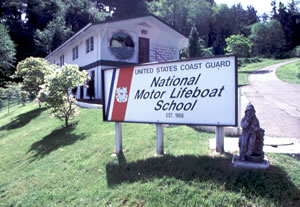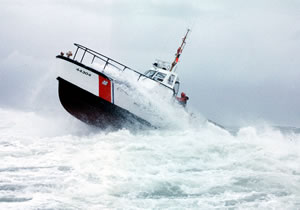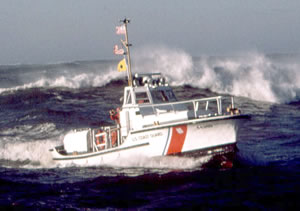





 At the mouth of the Columbia River on the state border between Oregon and Washington lies Cape Disappointment. Here where the great Pacific rollers meet the out rushing river as it disgorges its contents into the ocean, is an area known as "The Graveyard of the Pacific". It is also the daily work place and training ground for the United States Coastguard Motor Lifeboat School. Instructors and students make use of the almost constant heavy surf to practice the techniques necessary for handling 44ft lifeboats, which are virtually the same as our Waveney class, in heavy weather. Situations which require the helmsman to take positive, precise and correct action abound and are constantly monitored by the instructor standing at his side.
At the mouth of the Columbia River on the state border between Oregon and Washington lies Cape Disappointment. Here where the great Pacific rollers meet the out rushing river as it disgorges its contents into the ocean, is an area known as "The Graveyard of the Pacific". It is also the daily work place and training ground for the United States Coastguard Motor Lifeboat School. Instructors and students make use of the almost constant heavy surf to practice the techniques necessary for handling 44ft lifeboats, which are virtually the same as our Waveney class, in heavy weather. Situations which require the helmsman to take positive, precise and correct action abound and are constantly monitored by the instructor standing at his side. The Motor Lifeboat School is under the command of Chief Warrant Officer Gary Walker. His staff of 10 expert instructors teach 11 one-month duration classes during each year, both afloat and in the classroom. The staff assume that the students are already competent lifeboat coxswains and that their knowledge of navigation, boat handling, etc. is sound, in order that they may concentrate, in the main, on the heavy weather practical aspects.
The Motor Lifeboat School is under the command of Chief Warrant Officer Gary Walker. His staff of 10 expert instructors teach 11 one-month duration classes during each year, both afloat and in the classroom. The staff assume that the students are already competent lifeboat coxswains and that their knowledge of navigation, boat handling, etc. is sound, in order that they may concentrate, in the main, on the heavy weather practical aspects. A new experience for most was the surf swim! This required teams of three to jump overboard into the surf and swim ashore experiencing all the problems that being in surf presents and also how to control the situation as far as that is possible, by understanding what is happening to the surf and the tidal rip.
A new experience for most was the surf swim! This required teams of three to jump overboard into the surf and swim ashore experiencing all the problems that being in surf presents and also how to control the situation as far as that is possible, by understanding what is happening to the surf and the tidal rip.